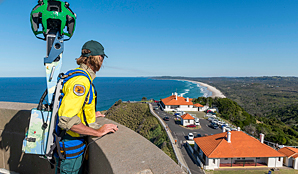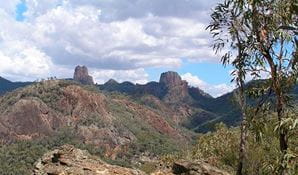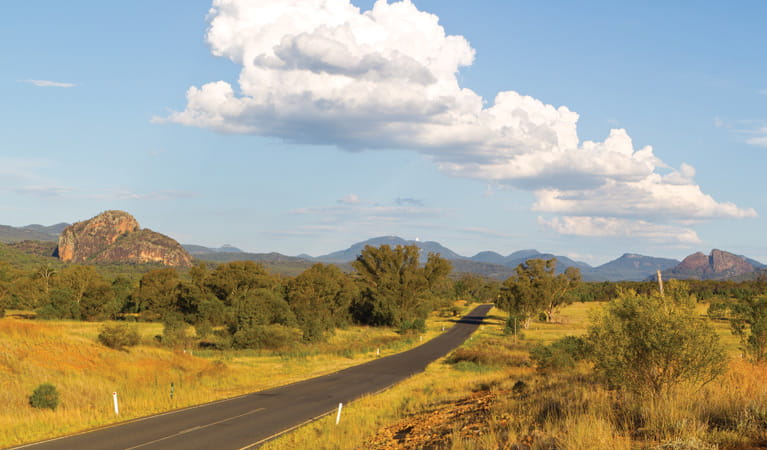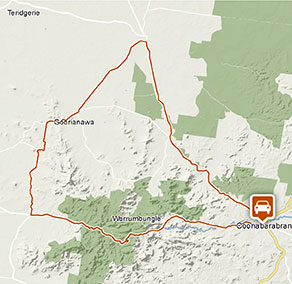Coonabarabran - Baradine - Warrumbungle drive
Country NSW
Overview
Explore the spectacular landscapes, historic towns, picnic spots and walks of the Warrumbungles and Pilliga, near Coonabarabran and Baradine, in NSW.
- Where
- Timmallallie National Park, Pilliga Nature Reserve, Warrumbungle National Park, Yarrigan National Park in Country NSW
- Distance
- 140km loop
- Time suggested
- 5hrs
- Entry fees
-
Park entry fees apply in Warrumbungle National Park
- Please note
- Visit Pilliga Forest Discovery Centre or Warrumbungles Visitor Centre to get more information about the drive.
- School holidays can be busy so you might want to book accommodation in advance.
- Some parts of the road are sealed and some are unsealed.
Coonabarabran-Baradine-Warrumbungle drive is a 130km scenic driving route in western NSW. It's a great way to discover the history, towns and natural wonders of Warrumbungle National Park and Pilliga Forest at your own pace.
Setting out from Coonabarabran, known as the 'Astronomy Capital of Australia' or 'Coona', head towards Baradine. Here a visit to the Pilliga Forest Discovery Centre is a must, then find out more about the Aboriginal history of the area at the Baradine Local Land Council Building. There are lots of Aboriginal artefacts, like emu callers, rain sticks, clapsticks and didgeridoos to name a few. A meal at the historic Tattersalls Hotel might be on the cards, and afterwards you could take a detour to the award-winning Sculptures in the Scrub walking track in the Pilliga Forest.
Last stop on the driving tour is Warrumbungle National Park, where your adventure has really just begun. Stretch your legs on a walk to take in views of the amazing volcanic scenery, and camp under the stars. Make sure you check out the Siding Spring Observatory.
Google Street View Trekker
Using Google Street View Trekker, we've captured imagery across a range of NSW national parks and attractions. Get a bird's eye view of these incredible landscapes before setting off on your own adventure.

Conservation program:
Warrumbungle National Park after-fire program
The 2013 bushfires were the largest and most intense on record for Warrumbungle National Park. Almost 90 per cent of the park was burnt, but conservation programs and research have helped us better understand the impact of fire and how the park has recovered.

General enquiries
- National Parks Contact Centre
- 7am to 7pm daily
- 1300 072 757 (13000 PARKS) for the cost of a local call within Australia excluding mobiles
- parks.info@environment.nsw.gov.au
Operated by
- Pilliga Forest Discovery Centre
- 9am to 4pm daily. Closed Christmas Day.
- 02 6843 4011
- pfdc@environment.nsw.gov.au
- 50-58 Wellington St, Baradine NSW 2396
Park info
- in Warrumbungle National Park in the Country NSW region
Warrumbungle National Park is always open but may have to close at times due to poor weather or fire danger.
-
Park entry fees:
$8 per vehicle per day.
Buy annual pass
- in Timmallallie National Park in the Country NSW region
- Open 24 hours 7 days
- in Yarrigan National Park in the Country NSW region
- in Pilliga Nature Reserve in the Country NSW region
What's nearby:
Things to do (34)
- 4WD touring (1)
- Aboriginal culture (4)
- Adventure sports (1)
- Birdwatching and wildlife encounters (8)
- Cultural heritage (1)
- Educational activities (1)
- Historic heritage (1)
- Other experiences (1)
- Picnics and barbecues (5)
- Road trips and car/bus tours (2)
- Sightseeing (20)
- Swimming (1)
- Visitor centres (2)
- Walking (21)
- Wildflowers (seasonal) (12)

